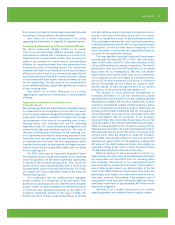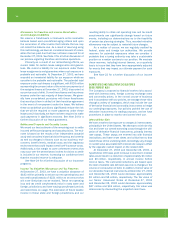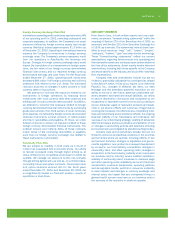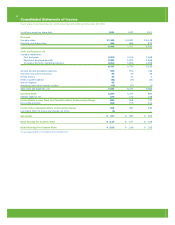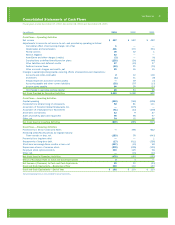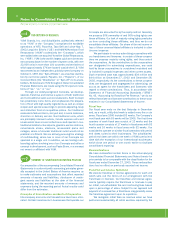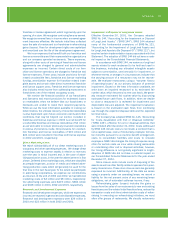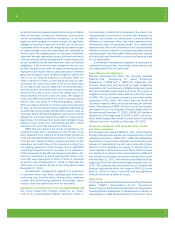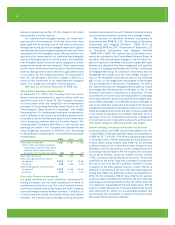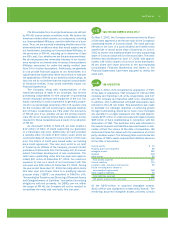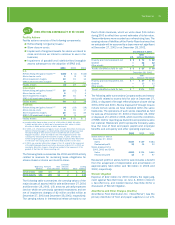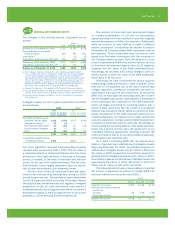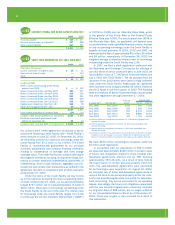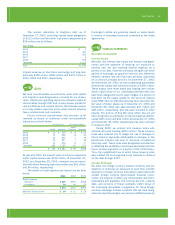Pizza Hut 2003 Annual Report Download - page 55
Download and view the complete annual report
Please find page 55 of the 2003 Pizza Hut annual report below. You can navigate through the pages in the report by either clicking on the pages listed below, or by using the keyword search tool below to find specific information within the annual report.
Yum! Brands Inc. 53.
franchise or license agreement, which is generally upon the
opening of a store. We recognize continuing fees as earned.
We recognize renewal fees in income when a renewal agree-
ment becomes effective. We include initial fees collected
upon the sale of a restaurant to a franchisee in refranchising
gains (losses). Fees for development rights are capitalized
and amortized over the life of the development agreement.
We incur expenses that benefit both our franchise and
license communities and their representative organizations
and our company operated restaurants. These expenses,
along with other costs of servicing of franchise and license
agreements are charged to general and administrative
expenses as incurred. Certain direct costs of our fran-
chise and license operations are charged to franchise and
license expenses. These costs include provisions for esti-
mated uncollectible fees, franchise and license marketing
funding, amortization expense for franchise related intan-
gible assets and certain other direct incremental franchise
and license support costs. Franchise and license expenses
also includes rental income from subleasing restaurants to
franchisees net of the related occupancy costs.
We monitor the financial condition of our franchisees
and licensees and record provisions for estimated losses
on receivables when we believe that our franchisees or
licensees are unable to make their required payments.
While we use the best information available in making our
determination, the ultimate recovery of recorded receivables
is also dependent upon future economic events and other
conditions that may be beyond our control. Included in
franchise and license expense in 2003 is a net benefit for
uncollectible franchise and license receivables of $3 million
as we were able to recover previously reserved receivables
in excess of provisions made. Net provisions for uncollect-
ible franchise and license receivables of $15 million and
$24 million were included in franchise and license expense
in 2002 and 2001, respectively.
Direct Marketing Costs
We report substantially all of our direct marketing costs in
occupancy and other operating expenses. We charge direct
marketing costs to expense ratably in relation to revenues
over the year in which incurred and, in the case of adver-
tising production costs, in the year the advertisement is first
shown. Deferred direct marketing costs, which are classified
as prepaid expenses, consist of media and related adver-
tising production costs which will generally be used for the
first time in the next fiscal year. To the extent we participate
in advertising cooperatives, we expense our contributions
as incurred. At the end of 2003 and 2002, we had deferred
marketing costs of $3 million and $8 million, respectively.
Our advertising expenses were $419 million, $384 million
and $328 million in 2003, 2002 and 2001, respectively.
Research and Development Expenses
Research and development expenses, which we expense as
incurred, are reported in general and administrative expenses.
Research and development expenses were $26 million in
2003 and $23 million in both 2002 and 2001.
Impairment or Disposal of Long-Lived Assets
Effective December 30, 2001, the Company adopted
SFAS No. 144, “Accounting for the Impairment or Disposal
of Long-Lived Assets” (“SFAS 144”). SFAS 144 retained
many of the fundamental provisions of SFAS No. 121,
“Accounting for the Impairment of Long-Lived Assets and
for Long-Lived Assets to Be Disposed Of” (“SFAS 121”), but
resolved certain implementation issues associated with that
Statement. The adoption of SFAS 144 did not have a mate-
rial impact on the Consolidated Financial Statements.
In accordance with SFAS 144, we review our long-lived
assets related to each restaurant to be held and used in
the business, including any allocated intangible assets
subject to amortization, semi-annually for impairment, or
whenever events or changes in circumstances indicate that
the carrying amount of a restaurant may not be recover-
able. We evaluate restaurants using a “two-year history
of operating losses” as our primary indicator of potential
impairment. Based on the best information available, we
write down an impaired restaurant to its estimated fair
market value, which becomes its new cost basis. We gener-
ally measure estimated fair market value by discounting
estimated future cash flows. In addition, when we decide
to close a restaurant it is reviewed for impairment and
depreciable lives are adjusted. The impairment evaluation
is based on the estimated cash flows from continuing
use through the expected disposal date and the expected
terminal value.
The Company has adopted SFAS No. 146, “Accounting
for Costs Associated with Exit or Disposal Activities”
(“SFAS 146”), effective for exit or disposal activities that
were initiated after December 31, 2002. Costs addressed
by SFAS 146 include costs to terminate a contract that is
not a capital lease, costs of involuntary employee termina-
tion benefits pursuant to a one-time benefit arrangement,
costs to consolidate facilities and costs to relocate
employees. SFAS 146 changes the timing of expense recog-
nition for certain costs we incur while closing restaurants
or undertaking other exit or disposal activities; however,
the timing difference is not typically significant in length.
Adoption of SFAS 146 did not have a material impact on
our Consolidated Financial Statements for the year ended
December 27, 2003.
Store closure costs include costs of disposing of the
assets as well as other facility-related expenses from previ-
ously closed stores. These store closure costs are generally
expensed as incurred. Additionally, at the date we cease
using a property under an operating lease, we record a
liability for the net present value of any remaining lease
obligations, net of estimated sublease income, if any.
Refranchising gains (losses) includes the gains or
losses from the sales of our restaurants to new and existing
franchisees and the related initial franchise fees, reduced by
transaction costs and direct administrative costs of refran-
chising. In executing our refranchising initiatives, we most
often offer groups of restaurants. We classify restaurants




